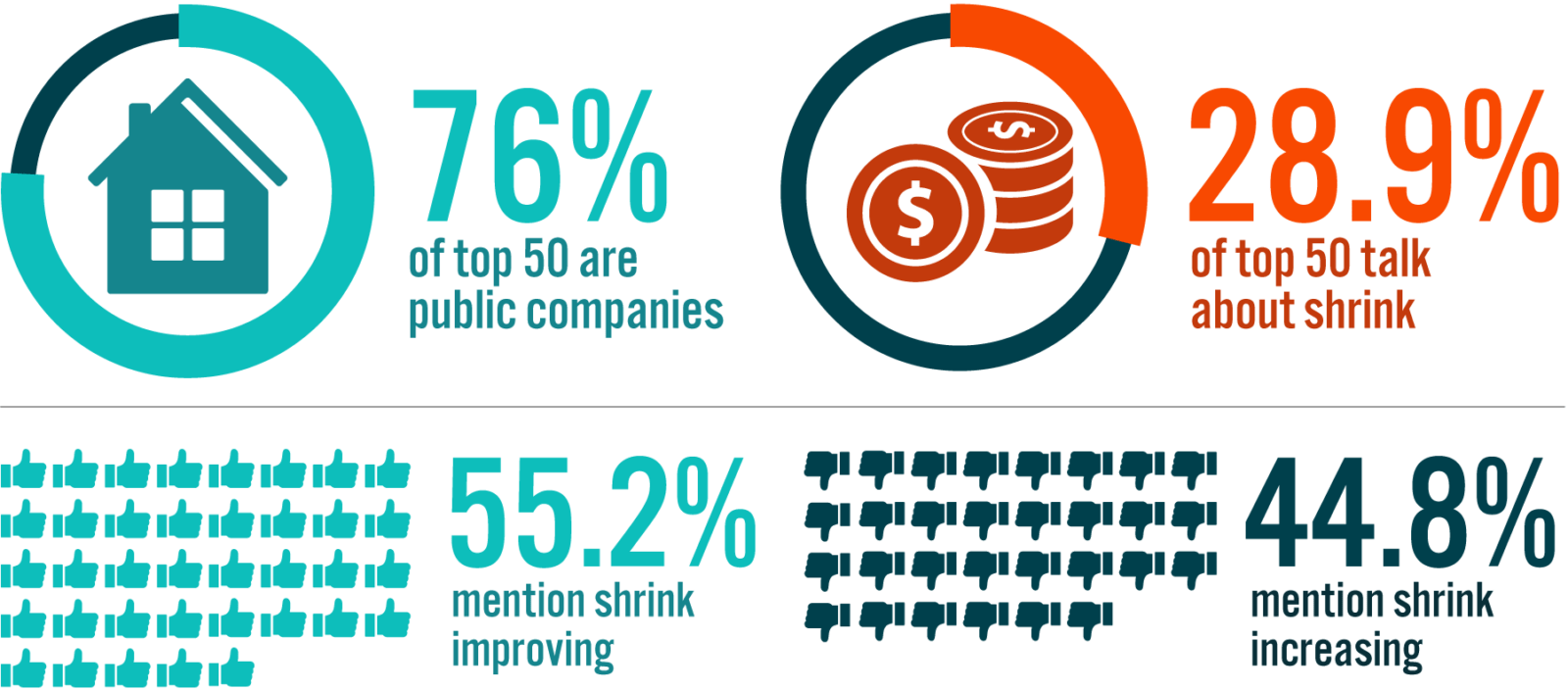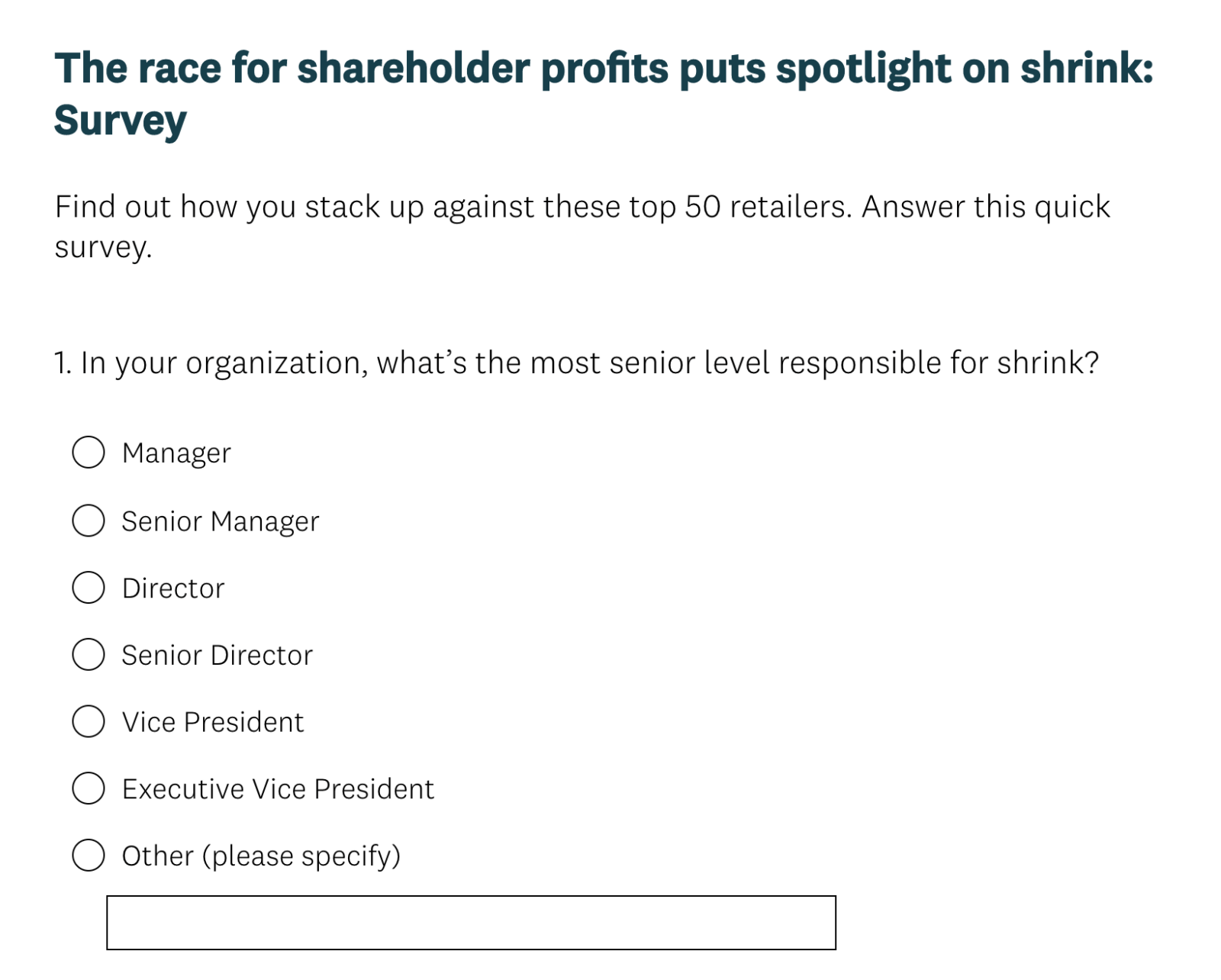We analyzed the earnings scripts from the top 50 retail companies in the US for the past 6 quarters. Only 29% discussed shrink with investors.
As competition grows, profit margins tighten, and employee retention gets more competitive, managing shrink continues to be a focus, and often a challenge for retailers. Shrink costs US retailers $61.7 billion according to the 2020 National Retail Security Survey.
The race for shareholder profits is bringing shrink to the forefront of executive conversations for retail companies. We combed through hundreds of earnings call scripts for 50 of the top retailers in the US to see how many executives attribute shrinkage as impacting financial performance. It’s not a perfect measure, but it does give visibility to the influence of loss/asset protection on bottom-line results in the largest retail chains.
We learned that shrinkage issues are affecting many retailers across the board, leading to gross margin pressure, price inflation and more. But some retailers are seeing positive gains because of the reduction in shrink. Here’s a summary of what we learned (all quotes courtesy The Motley Fool earnings call transcripts). The range of data includes 6 quarters, from Q1 2020 to Q2 2021 inclusive.
Background
The 50 companies we reviewed were a mixed bag of public and private corporations. We focused on the 76% (38) companies that are public and had earnings scripts available.
We then looked at how many companies mentioned shrink in earnings calls and learned that only 28.9% (11 companies) talked about shrink. Of those that mentioned shrink, there was a fairly even split between positive mentions (shrink improving 55.2%) vs negative mentions (shrink increasing 44.8%).

Retailers feel the shrink pinch
Retail shrinkage, most frequently caused by shoplifting and employee theft, has started to see growth from the impact of organized crime, creating a difficult situation for many retailers. Rodney McMullen, Chairman and CEO of the Kroger Company pointed out: “If you look at shrink, a lot of that, about …. 25% of it is driven within the shrinkage component and that’s heavily driven by organized crime or at least it appears to be. And I know Congress and other groups are starting to spend more time on understanding what’s driving that and what’s behind it and what’s the distribution channels for the stolen products as well and trying to manage that.
As many know, shrink continues to pressure gross margin for many in the retail industry.
Dave Denton, Executive Vice President of Lowes referenced shrink as one component of the pressure on gross margins, “Higher credit revenue drove 30 basis points of benefit to gross margin this quarter. These benefits were offset by 20 basis points of pressure from shrink and live good damages from the extreme weather conditions in the West, also 25 basis points of mix pressure related to lumber and 20 basis points from less favorable product mix in other categories.”
Other retailers see shrink improve
Food and drug retailer Albertson’s talks about progress they are making with shrink. Vivek Sankaran, President and Chief Executive Officer commented: “Our third strategic priority is driving productivity to support reinvestment in the business and help offset inflation. We are making progress against our productivity agenda, and we exceeded our internal expectations in Q1. During the quarter, we made significant progress in labor efficiency, shrinkage, promotions optimization, and indirect expense.”
Albertson’s Chief Financial Officer Bob Diamond spoke to the direct impact of shrinkage on gross margin, “As far as the 90-basis-point improvement relative to ’19, it’s really made up of several things here. We have had tremendous shrink improvement.”
Leading discount retailers Dollar Tree and Dollar General both highlighted the impact of shrink improvements on their bottom line.
Michael A. Witynski, Dollar Tree’s President and Chief Executive Officer said, “We’re optimizing which China and US ports we use to take advantage of the shipping availability, and our operations team is delivering shrink improvements through technology, enhanced processes and disciplined execution. We are confident that our teams will allow us to navigate through this period of global supply chain challenges.”
“For Q2 2021, gross profit as a percentage of sales was 31.6%, a decrease of 80 basis points, but an increase of 87 basis points compared to Q2 2019,” said John Garratt, Executive Vice President and Chief Financial Officer of Dollar General. “The decrease compared to Q2 2020 was primarily attributable to increased transportation costs, a higher LIFO provision, a greater proportion of sales coming from the consumable categories and an increase in inventory damages. These factors were partially offset by higher inventory markups and a reduction in shrink as a percentage of sales.”
Looking Ahead
While the sheer cost of US retail shrinkage may seem daunting, it’s simply part of business. As long as there are retailers, there will be retail loss. The trick for retailers is minimizing the losses.
Our deep dive into how retailers talk about shrink in earnings scripts shows a mixed bag of results. Some companies continue to see shrinkage pressure gross margins while others see a positive contribution from shrink reduction.
But it is clear that the impact of shrink on major retailers needs more executive attention with only 28.9% mentioning shrink. Loss prevention experts know that shoplifting and employee theft make up the bulk of the shrink problem for the retail industry—a reality that has a significant impact on retail companies, employees, and shoppers alike. The increase in incidents and the growth of organized crime are forcing retailers to invest in new technology to reduce inventory shrinkage.
As thieves become more sophisticated in their tactics, retailers have an opportunity to respond in kind. For both nationwide brands and local mom-and-pop stores, loss prevention technology can serve as a force multiplier, deterring and detecting theft in both new and tried-and-true ways. In today’s challenging retail landscape, these tools might be the difference between failure and success.
Find out how you stack up against these top 50 retailers. Answer this quick survey.
To learn how Solink can bring EBR, video and case management into one platform and help reduce shrink, click here.

